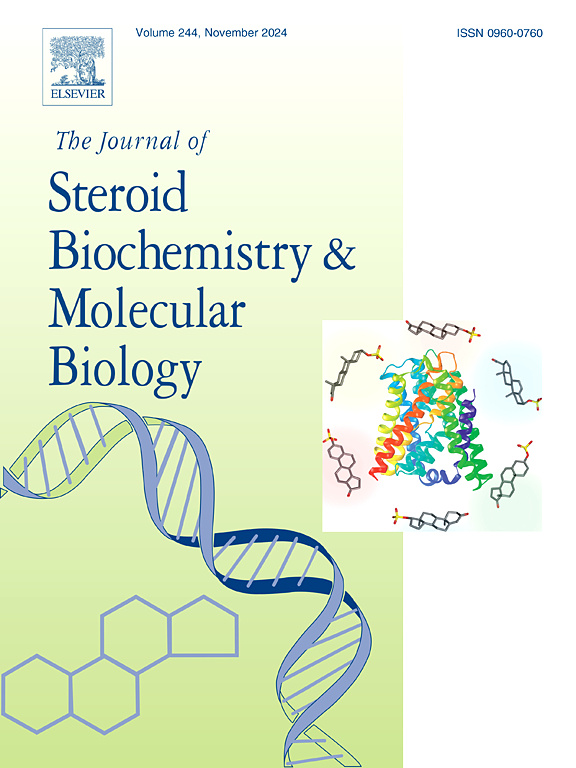Benzophenone UV-filters: Inhibition on human and rat 17β-hydroxysteroid dehydrogenase 1 - insights from 3D-QSAR and docking studies
IF 2.7
2区 生物学
Q3 BIOCHEMISTRY & MOLECULAR BIOLOGY
Journal of Steroid Biochemistry and Molecular Biology
Pub Date : 2025-03-21
DOI:10.1016/j.jsbmb.2025.106739
引用次数: 0
Abstract
Benzophenone (BP) UV-filters have been extensively used for the prevention of UV-induced adverse effects in personal care products. Their potential to interfere with steroidogenesis in the female reproductive system remains uncertain. 17β-Hydroxysteroid dehydrogenase 1 (17β-HSD1) facilitates the conversion of estrone to estradiol, playing a key role in estrogen activation. This study delves into the effects of eleven BPs on human and rat 17β-HSD1, while also analysing the 3D-quntitative structure-activity relationship (3D-QSAR) and the underlying mechanisms. The inhibitory potency of inhibiting human placental 17β-HSD1 was found to be in the order of BP-2 (IC50, 11.42 μM) > BP-1 (14.17 μM) > BP-4 (49.05 μM) > BP-6 (63.49 μM) = BP-8 (63.46 μM) > others. BP-1 and BP-2 markedly inhibited estradiol secretion by human placental BeWo cells at ≥ 1 μM. In contrast, the inhibitory strength of suppressing rat ovarian 17β-HSD1 activity was found to be in the order of BP-2 (IC50, 13.33 μM) > BP-1 (15.09 μM) > BP-4 (22.68 μM) > BP-12 (31.12 μM) > BP-3 (97.11 μM) > BP (119.99 μM) > others. Mode action analysis revealed that these BP compounds acted as mixed inhibitors of both human and rat 17β-HSD1. The introduction of a 4-hydroxyl substitution in the benzene ring was found to markedly increase the inhibitory potency against human and rat 17β-HSD1. BP-1 and BP-2 demonstrated the ability to penetrate human BeWo cells and inhibit estradiol secretion at ≥ 1 μM. Docking analysis revealed that the 2-hydroxyl group of BP-1 and BP-2 forms a hydrogen bond with catalytic residue Ser142 of human 17β-HSD1. 3D-QSAR pharmacophore analysis showed that there are hydrophobic regions and hydrogen bond donor can interact with BPs. In conclusion, this study establishes that BP-2 is the most potent inhibitors of human 17β-HSD1 among the BPs under investigation, highlighting a significant difference in the structure-activity relationship.
二苯甲酮紫外线过滤器:对人和大鼠17β-羟基类固醇脱氢酶1的抑制作用——来自3D-QSAR和对接研究的见解
二苯甲酮(BP)紫外线滤光剂已广泛用于预防个人护理产品中紫外线引起的不良反应。它们是否有可能干扰女性生殖系统中的类固醇生成尚不确定。17β-羟基类固醇脱氢酶1 (17β-HSD1)促进雌酮转化为雌二醇,在雌激素活化中起关键作用。本研究深入探讨了11种bp对人和大鼠17β-HSD1的影响,同时分析了3d -定量构效关系(3D-QSAR)及其潜在机制。对人胎盘17β-HSD1的抑制效价依次为BP-2 (IC50, 11.42 μM) >; BP-1 (14.17 μM) >; BP-4 (49.05 μM) >; BP-6 (63.49 μM) = BP-8 (63.46 μM) >; others。BP-1和BP-2在≥ 1 μM时显著抑制人胎盘BeWo细胞的雌二醇分泌。抑制大鼠卵巢17β-HSD1活性的抑制强度依次为:BP-2 (IC50, 13.33 μM) >; BP-1 (15.09 μM) >; BP-4 (22.68 μM) >; BP-12 (31.12 μM) >; BP-3 (97.11 μM) >;BP (119.99 μM) >; others。模式作用分析表明,这些BP化合物可作为人和大鼠17β-HSD1的混合抑制剂。在苯环中引入一个4-羟基取代,可以显著提高对人和大鼠17β-HSD1的抑制效力。BP-1和BP-2能够穿透人BeWo细胞,抑制≥ 1 μM的雌二醇分泌。对接分析发现BP-1和BP-2的2羟基与人17β-HSD1的催化残基Ser142形成氢键。3D-QSAR药效团分析表明,该化合物存在疏水区,氢键供体可与bp相互作用。综上所述,本研究确定BP-2是所研究的bp中最有效的人类17β-HSD1抑制剂,并强调了结构-活性关系的显著差异。
本文章由计算机程序翻译,如有差异,请以英文原文为准。
求助全文
约1分钟内获得全文
求助全文
来源期刊
CiteScore
8.60
自引率
2.40%
发文量
113
审稿时长
46 days
期刊介绍:
The Journal of Steroid Biochemistry and Molecular Biology is devoted to new experimental and theoretical developments in areas related to steroids including vitamin D, lipids and their metabolomics. The Journal publishes a variety of contributions, including original articles, general and focused reviews, and rapid communications (brief articles of particular interest and clear novelty). Selected cutting-edge topics will be addressed in Special Issues managed by Guest Editors. Special Issues will contain both commissioned reviews and original research papers to provide comprehensive coverage of specific topics, and all submissions will undergo rigorous peer-review prior to publication.

 求助内容:
求助内容: 应助结果提醒方式:
应助结果提醒方式:


